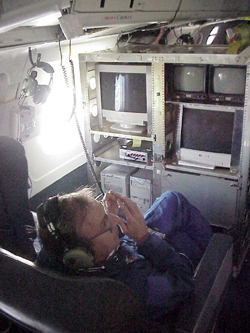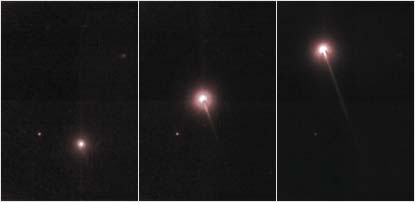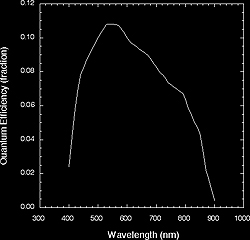|
IHFRI - Intensified High Frame Rate Imager
Instrument P.I.: Hans Stenbaek-Nielsen, University of Alaska at Fairbanks.
The information below will be updated as more precise data is received.
Technique: Intensified high-speed imaging (and slit-less spectroscopy).
Scientific objective: Provide imaging (and spectral) information at a rate of 1000 frames per second for detection of ablation anomalies, flicker in bowshock emissions, spacecraft rotation, and wake.
 Instrument: This instrument consists of a 6 inch clear aperature f0.75/105 mm lens and 256 x 256 pixel intensified CCD camera. The field of view is 6.25 x 6.25 degrees, illuminating 11.5 x 11.5 mm of the photocathode of the intensifier. The intensifier phospher has a brief decay time constant of 0.8 ms, ideally suited to study the natural afterglow in rapidly moving targets. It can be equipped with a low dispersion 7 inch 300 l/mm grating, providing a spectrum from 500 nm (15.9 mm from zero order) to 900 nm (29.4 mm from zero order) just outside the field of view. Spectrum can be recorded by pointing away from the SRC and will help target acquisition by providing a ray directed to the zero order.
Instrument: This instrument consists of a 6 inch clear aperature f0.75/105 mm lens and 256 x 256 pixel intensified CCD camera. The field of view is 6.25 x 6.25 degrees, illuminating 11.5 x 11.5 mm of the photocathode of the intensifier. The intensifier phospher has a brief decay time constant of 0.8 ms, ideally suited to study the natural afterglow in rapidly moving targets. It can be equipped with a low dispersion 7 inch 300 l/mm grating, providing a spectrum from 500 nm (15.9 mm from zero order) to 900 nm (29.4 mm from zero order) just outside the field of view. Spectrum can be recorded by pointing away from the SRC and will help target acquisition by providing a ray directed to the zero order.
Heritage: This camera was deployed before for meteor imaging in the 2002 Leonid MAC mission. Same rack setup.
Aircraft hardware requirements: Window swivel mount. Rack-mounted computer and control unit.
Instrument validation tests: This camera has been used extensively in past missions. Combination with low dispersion grating still needs to be tested.

Sensitivity: At 1000 frames/s, gray level 255 is reached at a surface brightness of 3 Mega-Rayleigh at 700 nm, which is about 25 percent of the CCD well depth. Gain is set for saturation to occur only at a higher brightness level to surpress blooming. Meteors of magnitude -3 were detected and discovered to have a halo from UV light generated from collisions with the air.
Dynamic range: 8-bit (factor 256).
Frame rate and exposure times: Exposure time: 1/1000s. The camera has a 4000 frame circular digital buffer. Recording is manually triggered as soon as the object enters the field of view, at which time the previous 4 seconds are recorded as well.
Spectral resolution - gives the FWHM of an instrument-broadened unresolved atomic spectral line:
In first order: 1.3 nm/pixel (FWHM ~ 4 nm).
Relative spectral response - gives the wavelength dependence of the combined system (window, lens, spectrograph, and CCD camera). The Quantum Efficiency of the system depends somewhat on the angle of viewing through the window (window absorption at the near-UV cut-off). Values need to be multiplied by cos(angle), with angle the viewing angle of the camera away from the position of the Sample Return Capsule:

wavelength: Quantum Efficiency:
(nm) (fraction)
400.0 0.024
410.0 0.041
420.0 0.058
430.0 0.068
440.0 0.078
450.0 0.083
460.0 0.086
470.0 0.090
480.0 0.094
490.0 0.097
500.0 0.100
510.0 0.103
520.0 0.106
530.0 0.108
540.0 0.108
550.0 0.108
560.0 0.108
570.0 0.108
580.0 0.105
590.0 0.102
600.0 0.100
610.0 0.097
620.0 0.096
630.0 0.095
640.0 0.094
650.0 0.093
660.0 0.091
670.0 0.090
680.0 0.087
690.0 0.085
700.0 0.083
710.0 0.080
720.0 0.079
730.0 0.076
740.0 0.074
750.0 0.072
760.0 0.071
770.0 0.070
780.0 0.069
790.0 0.068
800.0 0.064
810.0 0.059
820.0 0.055
830.0 0.050
840.0 0.047
850.0 0.044
860.0 0.034
870.0 0.022
880.0 0.017
890.0 0.010
900.0 0.004
|










 Instrument: This instrument consists of a 6 inch clear aperature f0.75/105 mm lens and 256 x 256 pixel intensified CCD camera. The field of view is 6.25 x 6.25 degrees, illuminating 11.5 x 11.5 mm of the photocathode of the intensifier. The intensifier phospher has a brief decay time constant of 0.8 ms, ideally suited to study the natural afterglow in rapidly moving targets. It can be equipped with a low dispersion 7 inch 300 l/mm grating, providing a spectrum from 500 nm (15.9 mm from zero order) to 900 nm (29.4 mm from zero order) just outside the field of view. Spectrum can be recorded by pointing away from the SRC and will help target acquisition by providing a ray directed to the zero order.
Instrument: This instrument consists of a 6 inch clear aperature f0.75/105 mm lens and 256 x 256 pixel intensified CCD camera. The field of view is 6.25 x 6.25 degrees, illuminating 11.5 x 11.5 mm of the photocathode of the intensifier. The intensifier phospher has a brief decay time constant of 0.8 ms, ideally suited to study the natural afterglow in rapidly moving targets. It can be equipped with a low dispersion 7 inch 300 l/mm grating, providing a spectrum from 500 nm (15.9 mm from zero order) to 900 nm (29.4 mm from zero order) just outside the field of view. Spectrum can be recorded by pointing away from the SRC and will help target acquisition by providing a ray directed to the zero order.

